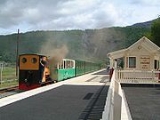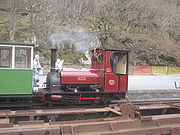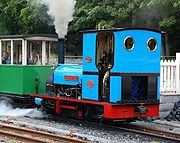
Llanberis Lake Railway
Encyclopedia


The Llanberis Lake Railway is a narrow gauge heritage railway
Heritage railway
thumb|right|the Historical [[Khyber train safari|Khyber Railway]] goes through the [[Khyber Pass]], [[Pakistan]]A heritage railway , preserved railway , tourist railway , or tourist railroad is a railway that is run as a tourist attraction, in some cases by volunteers, and...
that runs for 2.5 miles (4 km) along the northern shore of Llyn Padarn
Llyn Padarn
Llyn Padarn is a glacially formed lake in Snowdonia, Gwynedd, north Wales, and is an example of a moraine dammed lake. The lake is approximately long and at its deepest point is deep. At its south-eastern end it is linked to the neighbouring Llyn Peris...
in north Wales
Wales
Wales is a country that is part of the United Kingdom and the island of Great Britain, bordered by England to its east and the Atlantic Ocean and Irish Sea to its west. It has a population of three million, and a total area of 20,779 km²...
in the Snowdonia
Snowdonia
Snowdonia is a region in north Wales and a national park of in area. It was the first to be designated of the three National Parks in Wales, in 1951.-Name and extent:...
National Park. The starting point is the town of Llanberis
Llanberis
Llanberis is a village in Gwynedd, North Wales, lying on the southern banks of Llyn Padarn in Snowdonia. It takes its name from Saint Peris, an early Welsh saint.According to the United Kingdom Census 2001, the population of Llanberis was 1,954...
at the eastern end of the lake (53.1175°N 4.1193°W), with the western terminus at Pen Llyn in the Padarn Country Park (53.1370°N 4.1495°W). The return journey takes around 45 minutes.
Early proposals
The Llanberis Lake Railway runs along part of the trackbed of the defunct Padarn RailwayPadarn Railway
The Padarn Railway was a narrow gauge railway line in Wales, built to the unusual gauge of . It was built to carry slate from the Dinorwic Quarry to Port Dinorwic. It opened in 1842, replacing the previous Dinorwic Railway. The Padarn Railway closed in 1961 .An unusual feature of the railway were...
, a gauge line which connected the quarry with Y Felinheli
Y Felinheli
Y Felinheli is a village lying beside the Menai Strait between Bangor and Caernarfon in Gwynedd, north-west Wales. The population is about 2,200.-Etymology:...
(Port Dinorwic) on the Menai Strait
Menai Strait
The Menai Strait is a narrow stretch of shallow tidal water about long, which separates the island of Anglesey from the mainland of Wales.The strait is bridged in two places - the main A5 road is carried over the strait by Thomas Telford's elegant iron suspension bridge, the first of its kind,...
. The Padarn Railway closed in October 1961 and was lifted between 16 May 1962 and February 1963. Following the closure of the Padarn Railway, various plans were made to open a gauge tourist railway on the trackbed. The first serious attempt was made by G. Ward a local resident, who proposed a railway that would circle Llyn Padarn using the trackbeds of the British Rail
British Rail
British Railways , which from 1965 traded as British Rail, was the operator of most of the rail transport in Great Britain between 1948 and 1997. It was formed from the nationalisation of the "Big Four" British railway companies and lasted until the gradual privatisation of British Rail, in stages...
Llanberis branch and the Padarn Railway. This plan would have utilized track and locomotives from the Dinorwic
Dinorwic Quarry
The Dinorwic Slate Quarry is a large former slate quarry, now home to the Welsh National Slate Museum, located between the villages of Llanberis and Dinorwig in north Wales. It was the second largest slate quarry in Wales, indeed in the world, after the neighbouring Penrhyn Quarry....
slate
Slate
Slate is a fine-grained, foliated, homogeneous metamorphic rock derived from an original shale-type sedimentary rock composed of clay or volcanic ash through low-grade regional metamorphism. The result is a foliated rock in which the foliation may not correspond to the original sedimentary layering...
quarry, but the company did not pursue the proposal.
Quarry closure and formation of the railway company
In July 1966, A. Lowry Porter of Southend-on-SeaSouthend-on-Sea
Southend-on-Sea is a unitary authority area, town, and seaside resort in Essex, England. The district has Borough status, and comprises the towns of Chalkwell, Eastwood, Leigh-on-Sea, North Shoebury, Prittlewell, Shoeburyness, Southchurch, Thorpe Bay, and Westcliff-on-Sea. The district is situated...
proposed a shorter railway running from the quarry company's workshops at Gilfach Ddu near Llanberis to Penllyn, along the eastern-most three miles of Padarn Railway trackbed. Negotiations were progressing with the company, when in July 1969 the quarry closed at short notice. The quarry's workshops at Gilfach Ddu were purchased by the Gwynedd County Council with the intention of creating a Country Park.
The quarry's land and equipment were put up for auction, and Lowry Porter's fledgling railway company purchased three steam locomotives and one diesel locomotive for use on the planned lake railway. In June 1970 the County Council purchased the trackbed of the Padarn Railway and agreed to allow its use for the lake railway.
The Ruston diesel locomotive was quickly put into service laying track. Meanwhile, the first steam locomotive, Dolbadarn, was restored to working order. The new railway was built to the gauge of instead of the more unusual used in the quarries. This required all the rolling stock to be regauged, including the locomotives. Tracklaying progressed during 1970 using track recovered from several sources, including some originally used on the Lynton and Barnstaple Railway
Lynton and Barnstaple Railway
The Lynton & Barnstaple Railway opened as an independent railway in May 1898. It was a single track narrow gauge railway slightly over long running through the rugged and picturesque area bordering Exmoor in North Devon, England. Although opened after the 1896 Light Railways Act came into force,...
.
New carriages were built using the chasses of bogie wagons. These initial efforts at creating passenger stock proved unsatisfactory — they had a tendency to derail due to their very rigid construction. This caused a delay in opening, and a subsequent rapid redesign of the carriages.
Early years
The railway officially opened on 28 May 1971 but because of the need to redesign the carriage stock, the first public trains did not run until 19 July 1971. By the end of the first season, more than 30,000 passengers had been carried. In the winter of 1971 the railway was extended to its current terminus at Penllyn. For the beginning of the 1972 season, a second steam locomotive Red Damsel was returned to service with a new name: Elidir. The locomotive roster was expanded that year to include Maid MarianMaid Marian (locomotive)
Maid Marian is a preserved narrow-gauge steam locomotive built in 1903, currently based at on the Bala Lake Railway in North Wales.- Construction :...
(now operating on the Bala Lake Railway
Bala Lake Railway
The Bala Lake Railway is a preserved railway at Bala Lake, in Gwynedd, north Wales, which runs for a distance of using gauge rolling stock....
) and an 0-4-0 tank locomotive
Tank locomotive
A tank locomotive or tank engine is a steam locomotive that carries its water in one or more on-board water tanks, instead of pulling it behind it in a tender. It will most likely also have some kind of bunker to hold the fuel. There are several different types of tank locomotive dependent upon...
built by Jung in Germany.
Llanberis extension
In June 2003 the railway was extended to the town of Llanberis, with a new station close to the start of the Snowdon Mountain RailwaySnowdon Mountain Railway
The Snowdon Mountain Railway is a narrow gauge rack and pinion mountain railway in Gwynedd, north-west Wales. It is a tourist railway that travels for from Llanberis to the summit of Snowdon, the highest peak in England and Wales....
. The original terminus at Gilfach Ddu is now a through station serving both the National Slate Museum and the nearby Dolbadarn Castle
Dolbadarn Castle
Dolbadarn Castle is a fortification built by the Welsh prince Llywelyn the Great during the early 13th century, at the base of the Llanberis Pass, in North Wales. The castle was important both militarily and as a symbol of Llywelyn's power and authority. The castle features a large stone keep,...
. On the return journey from Pen Llyn, passengers may stop off at the Cei Llydan station for a picnic and a chance to enjoy the magnificent views of the Snowdonian mountains above Llanberis Pass.
Operations
The railway uses three steam locomotives (“Elidir“, “Dolbadarn” and “Thomas Bach”) all of which ran on the internal gauge lines of the Dinorwic QuarryDinorwic Quarry
The Dinorwic Slate Quarry is a large former slate quarry, now home to the Welsh National Slate Museum, located between the villages of Llanberis and Dinorwig in north Wales. It was the second largest slate quarry in Wales, indeed in the world, after the neighbouring Penrhyn Quarry....
. There are also several diesel locomotives which are used for works trains and when the steam locomotives are unavailable for passenger trains.
When the Quarry closed down in 1969 the lakeside section of the trackbed was utilised for the current Llanberis Lake Railway, originally running from the National Slate Museum at Gilfach Ddu to Pen Llyn. Gilfach Ddu was the main engineering workshop of the Dinorwic Quarry and provided repair facilities for all of the steam locomotives of the quarry system.
Locomotives

| Number | Name | Builder | Type | Works number | Date | Notes |
|---|---|---|---|---|---|---|
| 1 | Elidir | Hunslet Hunslet Engine Company The Hunslet Engine Company is a British locomotive-building company founded in 1864 at Jack Lane, Hunslet, Leeds, West Yorkshire, England by John Towlerton Leather, a civil engineering contractor, who appointed James Campbell as his Works Manager.In 1871, James Campbell bought the company for... |
493 | 1899 | Built for the Dinorwic quarry; originally named Enid then later re-named Red Damsel | |
| 2 | Thomas Bach | Hunslet Hunslet Engine Company The Hunslet Engine Company is a British locomotive-building company founded in 1864 at Jack Lane, Hunslet, Leeds, West Yorkshire, England by John Towlerton Leather, a civil engineering contractor, who appointed James Campbell as his Works Manager.In 1871, James Campbell bought the company for... |
894 | 1904 | Built for the Dinorwic quarry; originally named Wild Aster | |
| 3 | Dolbadarn | Hunslet Hunslet Engine Company The Hunslet Engine Company is a British locomotive-building company founded in 1864 at Jack Lane, Hunslet, Leeds, West Yorkshire, England by John Towlerton Leather, a civil engineering contractor, who appointed James Campbell as his Works Manager.In 1871, James Campbell bought the company for... |
1430 | 1922 | Built for the Dinorwic quarry | |
| 3 | Maid Marian Maid Marian (locomotive) Maid Marian is a preserved narrow-gauge steam locomotive built in 1903, currently based at on the Bala Lake Railway in North Wales.- Construction :... |
Hunslet Hunslet Engine Company The Hunslet Engine Company is a British locomotive-building company founded in 1864 at Jack Lane, Hunslet, Leeds, West Yorkshire, England by John Towlerton Leather, a civil engineering contractor, who appointed James Campbell as his Works Manager.In 1871, James Campbell bought the company for... |
822 | 1903 | Built for the Dinorwic quarry. Based on the Llanberis Lake Railway from 1972 to 1975. Subsequently operating on the Bala Lake Railway Bala Lake Railway The Bala Lake Railway is a preserved railway at Bala Lake, in Gwynedd, north Wales, which runs for a distance of using gauge rolling stock.... |
|
| 7 | Topsy | Ruston Hornsby Ruston (engine builder) Ruston & Hornsby, later known as Ruston, was an industrial equipment manufacturer in Lincoln, England, the company's history going back to 1840. The company is best known as a manufacturer of narrow and standard gauge diesel locomotives and also of steam shovels. Other products included cars, steam... |
4wDM | 441427 | 1961 | Built for Bestwood Colliery |
| 8 | Twll Coed | Ruston Hornsby Ruston (engine builder) Ruston & Hornsby, later known as Ruston, was an industrial equipment manufacturer in Lincoln, England, the company's history going back to 1840. The company is best known as a manufacturer of narrow and standard gauge diesel locomotives and also of steam shovels. Other products included cars, steam... |
4wDM | 268878 | 1952 | Worked at the Lodge Hill and Upnor Railway |
| 11 | Garrett | Ruston Hornsby Ruston (engine builder) Ruston & Hornsby, later known as Ruston, was an industrial equipment manufacturer in Lincoln, England, the company's history going back to 1840. The company is best known as a manufacturer of narrow and standard gauge diesel locomotives and also of steam shovels. Other products included cars, steam... |
4wDM | 198286 | 1939 | |
| 12 | Llanelli | Ruston Hornsby Ruston (engine builder) Ruston & Hornsby, later known as Ruston, was an industrial equipment manufacturer in Lincoln, England, the company's history going back to 1840. The company is best known as a manufacturer of narrow and standard gauge diesel locomotives and also of steam shovels. Other products included cars, steam... |
4wDM | 451901 | 1961 |

